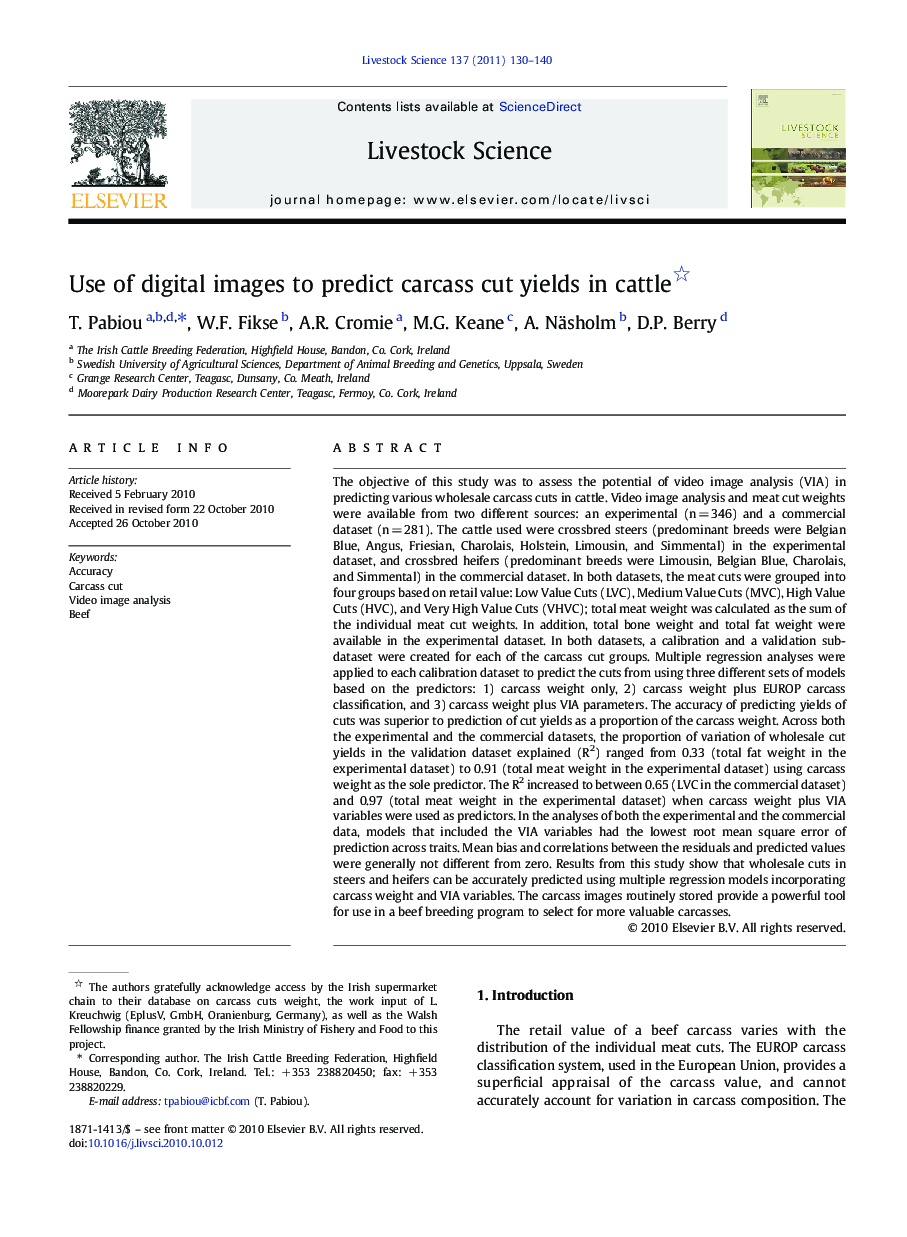| کد مقاله | کد نشریه | سال انتشار | مقاله انگلیسی | نسخه تمام متن |
|---|---|---|---|---|
| 5790967 | 1553995 | 2011 | 11 صفحه PDF | دانلود رایگان |
عنوان انگلیسی مقاله ISI
Use of digital images to predict carcass cut yields in cattle
دانلود مقاله + سفارش ترجمه
دانلود مقاله ISI انگلیسی
رایگان برای ایرانیان
موضوعات مرتبط
علوم زیستی و بیوفناوری
علوم کشاورزی و بیولوژیک
علوم دامی و جانورشناسی
پیش نمایش صفحه اول مقاله

چکیده انگلیسی
The objective of this study was to assess the potential of video image analysis (VIA) in predicting various wholesale carcass cuts in cattle. Video image analysis and meat cut weights were available from two different sources: an experimental (n = 346) and a commercial dataset (n = 281). The cattle used were crossbred steers (predominant breeds were Belgian Blue, Angus, Friesian, Charolais, Holstein, Limousin, and Simmental) in the experimental dataset, and crossbred heifers (predominant breeds were Limousin, Belgian Blue, Charolais, and Simmental) in the commercial dataset. In both datasets, the meat cuts were grouped into four groups based on retail value: Low Value Cuts (LVC), Medium Value Cuts (MVC), High Value Cuts (HVC), and Very High Value Cuts (VHVC); total meat weight was calculated as the sum of the individual meat cut weights. In addition, total bone weight and total fat weight were available in the experimental dataset. In both datasets, a calibration and a validation sub-dataset were created for each of the carcass cut groups. Multiple regression analyses were applied to each calibration dataset to predict the cuts from using three different sets of models based on the predictors: 1) carcass weight only, 2) carcass weight plus EUROP carcass classification, and 3) carcass weight plus VIA parameters. The accuracy of predicting yields of cuts was superior to prediction of cut yields as a proportion of the carcass weight. Across both the experimental and the commercial datasets, the proportion of variation of wholesale cut yields in the validation dataset explained (R2) ranged from 0.33 (total fat weight in the experimental dataset) to 0.91 (total meat weight in the experimental dataset) using carcass weight as the sole predictor. The R2 increased to between 0.65 (LVC in the commercial dataset) and 0.97 (total meat weight in the experimental dataset) when carcass weight plus VIA variables were used as predictors. In the analyses of both the experimental and the commercial data, models that included the VIA variables had the lowest root mean square error of prediction across traits. Mean bias and correlations between the residuals and predicted values were generally not different from zero. Results from this study show that wholesale cuts in steers and heifers can be accurately predicted using multiple regression models incorporating carcass weight and VIA variables. The carcass images routinely stored provide a powerful tool for use in a beef breeding program to select for more valuable carcasses.
ناشر
Database: Elsevier - ScienceDirect (ساینس دایرکت)
Journal: Livestock Science - Volume 137, Issues 1â3, May 2011, Pages 130-140
Journal: Livestock Science - Volume 137, Issues 1â3, May 2011, Pages 130-140
نویسندگان
T. Pabiou, W.F. Fikse, A.R. Cromie, M.G. Keane, A. Näsholm, D.P. Berry,